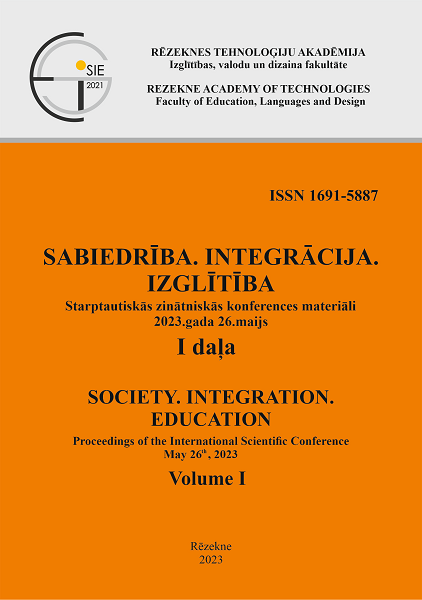ANXIETY AMONG SCHOOL-AGE CHILDREN IN WAR-AFFECTED AREAS IN UKRAINE AND WAYS TO REDUCE IT: PARENTS’ VIEWS
DOI:
https://doi.org/10.17770/sie2023vol1.7088Keywords:
anxiety, educational process, general secondary schools, school-age children, war-affected areas in Ukraine, web-based support system for educatorsAbstract
The Ukrainian-Latvian team of researchers are dedicated to commit their research to finding out parents’ views on whether school-age children experience anxiety in war-affected areas in Ukraine and ways to reduce it. The research also enables to identify the most common signs of anxiety. The data collection instrument includes a web-based questionnaire developed by researchers from Ukraine using Google Forms. All researchers are involved in sharing the developed web-based questionnaire via social media networks. The research sample includes 1346 parents of school-age children from all the parts of Ukraine, namely, Central, Eastern, Western, Northern, Southern Ukraine and Kyiv. Research findings demonstrate the urgent need to implement targeted psychological and pedagogical influences (the use of technologies, methods and techniques aimed at reducing the level of anxiety in school-aged children) in the educational process of general secondary schools, regardless of whether this process is carried out face-to-face, remotely or in a blended learning format. The conducted research makes it possible to substantiate the necessity of creating a web-based support system for educators to reduce anxiety among school-age children. The current research is carried out within the project “Web-based Support System for Educators to Reduce Children’s Anxiety in War-affected Areas” (Registration No GPK-07/2022).
References
Ataullahjan, A., Samara, M., Betancourt, T. S., & Bhutta, Z. A. (2020). Mitigating toxic stress in children affected by conflict and displacement. BMJ, 371: m2876. DOI: 10.1136/bmj.m2876
Betancourt, T. S., & Khan, K. T. (2008). The mental health of children affected by armed conflict: protective processes and pathways to resilience. International Review of Psychiatry, 20(3), 317–328. DOI: 10.1080/09540260802090363
Bethere, D., Cupere, I., Kaupuzs, A., Laganovska, E., Lubkina, V., Marzano, G., Prudnikova, I., Reigase, M., Rizakova, L., Rozenfelde, M., Rubene, Z., Rutka, L., Strods, R., Tubele, S., Usca, S., & Zogla, I. (2018). The development of an adolescent’s physical, emotional and social balance and inclusive education. Education Reform in Comprehensive School: Education Content Research and Implementation Problems, 0, 66–83. DOI: https://doi.org/10.17770/ercs2018.3608
Frounfelker, R. L., Islam, N., Falcone, J., Farrar, J., Ra, C., Antonaccio, C. M., Enelamah, N., & Betancourt, T. S. (2020). Living through war: Mental health of children and youth in conflict-affected areas. International Review of the Red Cross, 101(911), 481–506. DOI: 10.1017/S181638312000017X
Hall, A., & Ahmad, A. (2022). Millions of children’s development at stake: What can be done? Stockholm International Peace Research Institute. Retrieved from: https://www.sipri.org/commentary/topical-backgrounder/2022/child-development-and-resilience-war-conflict-and-displacement
International Committee of the Red Cross. (2011). Workshop report: CHILDREN AFFECTED BY ARMED CONFLICT AND OTHER SITUATIONS OF VIOLENCE [Datafile]. Retrieved from: https://www.icrc.org/en/doc/assets/files/publications/icrc-002-4082.pdf
Kadir, A., Shenoda, S., & Goldhagen, J. (2019). Effects of armed conflict on child health and development: A systematic review. PLoS ONE 14(1): e0210071.
Malykhin, O., Aristova, N., & Bondarchuk, J. (2022). Providing Quality Education to School-Age Children in Times of War in Ukraine: A Netnographic Analysis. The New Educational Review, 69, 180–190. DOI: https://doi.org/10.15804/tner.2022.69.3.14
Malykhin, O., Aristova, N., & Kalinina, L. (2022). Schoolteachers-parents interactions amid distance and blended learning: two-year experience of overcoming negative influences of Covid-19 pandemic. Society. Integration. Education. Proceedings of the International Scientific Conference, 1, 454–464. DOI: https://doi.org/10.17770/sie2022vol1.6858
Malykhin, O., Aristova, N., & Rohova, V. (2022). Minimizaciya osvitnih vtrat uchniv zakladiv zahalnoyi serednoyi osvity v umovah voennoho stanu: zmishane navchannya. Ukrayinskyj pedahohichnyj zhurnal, 3, 68–76. DOI: https://doi.org/10.32405/2411-1317-2022-3-68-76.
Schuman, C. (2022). Signs and symptoms of stress in kids. Parents. Retrieved from: https://www.parents.com/toddlers-preschoolers/development/fear/is-your-toddler-stressed/
Topuzov, O., Malykhin, O., & Aristova, N. (2021). System of psychological and didactic tasks players in the educational process face in the paradigm “Teachers – Schoolchildren – Parents” amid the Covid-19 pandemic. Education: Modern Discourses, 4, 23–31. DOI: https://doi.org/10.37472/2617-3107-2021-4-03.
United Nations Children’s Fund. (2022a). How to recognize size of distress in children. Retrieved from: https://www.unicef.org/parenting/child-care/how-to-recognize-signs-of-distress
United Nations Children’s Fund. (2022b). How to recognize stress in adolescents. Retrieved from: https://www.unicef.org/ukraine/en/stories/teens-stress
United Nations Children’s Fund. (2022c). 25 years of children and armed conflicts: taking action to protect children in war [Datafile]. Retrieved from: https://www.unicef.org/media/123021/file/25%20Years%20Children%20in%20Armed%20Conflict.pdf
United Nations Children’s Fund. (n.d.). What is stress. Retrieved from: https://www.unicef.org/parenting/mental-health/what-is-stress
Valizadeh, L., Farnam, A., & Farshi M. R. (2012). Investigation of stress symptoms among primary school children. J Caring Sci., 1(1), 25–30. DOI: 10.5681/jcs.2012.004
World Health Organization. (2021). Stress. Retrieved from https://www.who.int/news-room/questions-and-answers/item/stress






